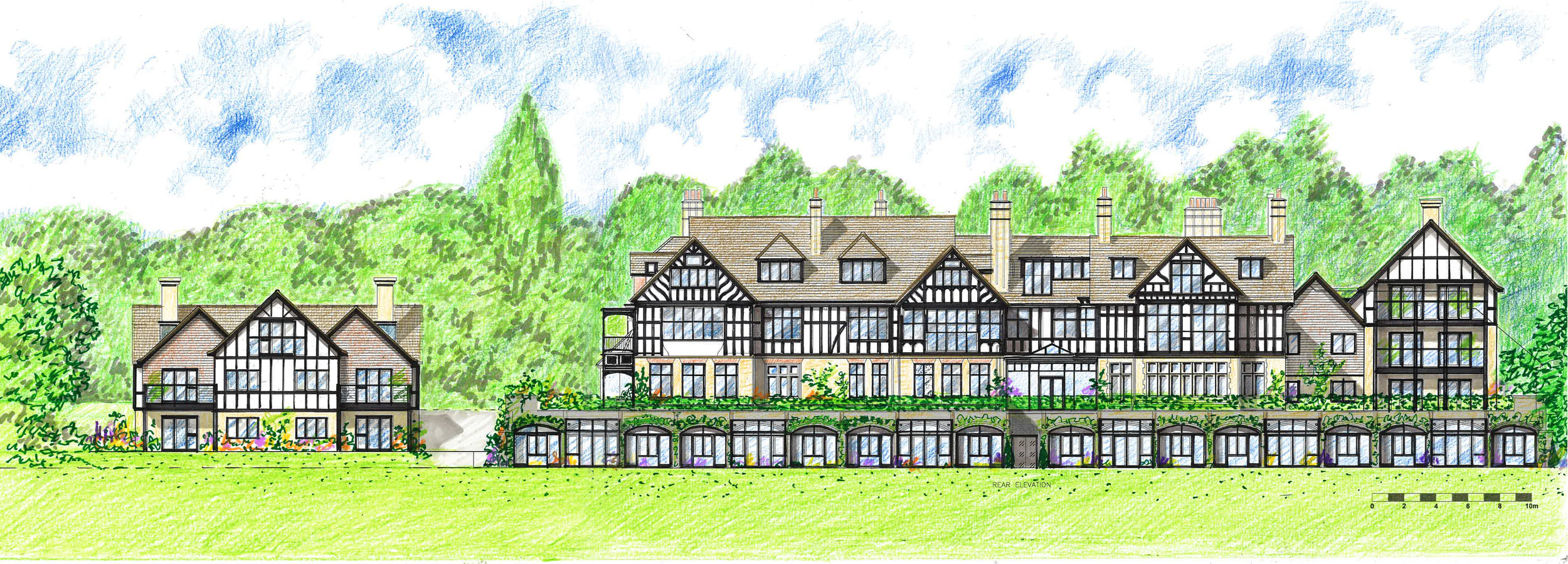Southall Surgery due to start on site in the new year
/Southall Surgery
Our application for the extension and major upgrading of the Guru Nanak clinic was approved recently and work is due to start on site in spring 2019.

Southall Surgery
Our application for the extension and major upgrading of the Guru Nanak clinic was approved recently and work is due to start on site in spring 2019.

Godalming
The application including the refurbishment of the splendid Edwardian Manor House was unanimously approved by the planning committee and we are now well advanced with the working drawings.

The Farthings Leatherhead
The scheme is due to be officially opened in January and we delighted to learn that it won Silver in the Best Retirement category at the recent ‘What House? Awards

Maryland Place St Albans
Work is well advanced on site with 9 units are now sold and many more reserved.

Lord Gardiner presenting HAPPI 4 at the House of Lords
HAPPI 4, a report on Housing for Older People in Rural Areas, was launched at an event in the House of Lords yesterday which Richard attended as one of those who gave attendance. The report was produced by the All Party Parliamentary Group on Housing and Care for Older People which is co-chaired by Lord Best and by Peter Aldous MP. The main speech was given by Lord Gardiner (pictured), the Parliamentary Under-Secretary of State for Rural Affairs who emphasised the huge importance of initiatives to improve the lives of the very high number of older people living in the countryside, before he and Lord Best dashed off for the Brexit vote. Some interesting info-graphics emerging from the report are shown here.
.

I chaired an interesting meeting yesterday with my Retirement Housing Group hat on to coordinate a sector response to the current MHCLG consultation on "Strengthening consumer redress in the housing market".
The proposals centre on the suggested need for a single housing ombudsman but there are other issues as well.
With representation from ARCO, RHG, Pegasus Life and McCarthy & Stone, plus two leads from MHCLG we had a very constructive meeting and hopefully raised government awareness of the specific issues relative to the Retirement Housing sector by a notch or two.

All aspects of expert witness work in construction litigation have their specific challenges and complexities, but work on cases involving construction defects, especially when there is a parallel repair brief, can be particularly involved and even hazardous. On one occasion, returning from a site in Somerset, I was almost arrested when a police officer spotted what she thought was a consignment of heroin in my case – it was actually a sample of failed render which I needed for testing – and in another case involving major repairs to an occupied block of flats I found that my site visits were being logged by the police because one of the tiniest flats was being used as a brothel!
Happily, I came through these and other incidents unscathed but there are many other aspects of building defect work which make it notably different from investigations of planning or contract disputes. First is the fact that there may well be dozens or even hundreds of different defects arising from poor design and construction of a single project and each one will probably need to be separately investigated to find out what has gone wrong, who is responsible and how serious the problem is. Then, if you have a dual brief to report and repair, you will also need to work out what to do about each one and to incorporate that into an overall repair contract. This can, as you may imagine become extremely complex and time consuming.
My first involvement with such work was in the 1980s when the practice I was with then was instructed by a Housing Association to investigate two seriously defective developments in Barnet. This was in the days when we still built large numbers of houses and flats in the UK and in this case an architect, an engineer and a QS had set up our client Association and then been swamped by approvals for 30 or more projects in a very short space of time. The schemes, moreover, were in many cases intricately designed, increasing the numbers of dwellings on constrained sites but, at the same time, generating great numbers of complex detailing and construction problems.
Almost inevitably, as the schemes were finished and occupied, it became clear that great numbers of them were riddled with serious defects, often with the same problems rearing their heads in several different developments where incorrect details had been passed from one contract to the next. A drawing for one particularly poor parapet detail had been passed from one team to another with a hasty note added: ‘We’ve had a lot of problems with this; hope you have better luck.’ - but to no avail. Nor were the problems confined to those caused by incorrect and inadequate detailing; poor construction and lax site inspection were also major contributory factors.
The first difficulty for the expert in cases like this is simply to discover what the problems are. Detailed site inspections, analysis of the files and occupier interviews all help to build the picture but it can still be very unclear how many separate problems you are dealing with and in one case a major drain failure below the building only came to light very late in the day when a resident, who had been refusing to give access for inspection, ran off leaving a small mountain of unpaid bills and a flat with damp patches half way up the walls.
Once the problems affecting each development have been identified- and there may sometimes be dozens of different failures to deal with – the next essential is an understanding of ‘building pathology’. The huge damp marks on the ceiling of a particular flat may result from a roof failure, from interstitial condensation, from the builders’ failure to connect the bath in the flat above or from the empty scotch bottle bridging the cavity of the external wall. The huge cracks in the brickwork may be caused by clay heave distorting the foundations where a large tree has been removed, by the lack of movement joints or by the failure to ensure that balconies are adequately fixed back to the main building structure.
With every problem, scrupulous analysis is needed to achieve a real understanding of the cause or causes before any attempt can be made to consider questions of negligence and it may also be necessary to reach a view on precisely when any defect occurred. This was particularly so at the time of my first involvement with building defects work, when case law on architect’s liability in tort and on limitations relating to latent defects was changing constantly.
When I was first involved with work of this type it worried me occasionally to be pursuing other hard-pressed architects and it was certainly a difficult time for the profession. Mandatory fee scales had recently gone but there was no possibility of practicing as a limited company, judgements were pushing liability ever further into the future and Housing Corporation policy was to pursue architects in all cases. PI insurance premiums shot up to form 10% or more of turnover.
Looking at the matter more dispassionately though it can never be right if a few architects take to cutting corners, however difficult the circumstanced, and identifying those whose work is negligent has to benefit the profession in the long term. Often such negligence results from obvious causes - persistent failure to resource the work adequately and the use of junior staff without checking their work for instance – but there is also a particularly architectural failure where the client’s best interests are swept aside as the architect single mindedly pursues his vision of ‘his’ building.
I have come across a case recently where, as part of his design concept for a house, the architect drew up an entirely bespoke window system with very large sliding and pivot doors, instead of selecting a manufacturer’s system which had been through the processes and testing of a normal product design programme. Great care was lavished on the details, large numbers of drawings were produced and the finished windows look very fine but they were hugely expensive, the long lead in times contributed to serious delays, they are not properly ‘weathered’ to keep the rain out, they do not include effective thermal breaks to cut condensation risks, they do provide properly for ventilation and they are so enormously heavy that it usually needs two people to open them.
This is difficult territory because I consider it essential that experts should also be involved in normal architectural practice and in that part of my life I spend a lot of time and effort resisting attempts by clients, quantity surveyors and others, to ‘dumb down’ my designs. I think it is entirely right that architects should push against the limits to create exciting new buildings, but at the end of the day a piece of concept design which has gone completely off the rails is as much a defect as bridged cavity or a leaking parapet detail.

Dan Cruikshank visited our in church in Hatfield yesterday with a TV crew making a documentary about the work of the Commonwealth War Graves Commission which will be broadcast in November. The Cecil family from Hatfield House had lost three sons in the Great War and they are commemorated in the beautiful window in the picture. Their mother, Lady Florence Cecil, led fierce opposition to the CWGC, who insisted that the bodies of fallen soldiers could not be repatriated for burial, but she was unsuccessful. It was a good way to spend a snowy afternoon, talking to Dan about this and showing him some of the other church treasures.
Richard
We have recently submitted a planning application for the extension and refurbishment of a GP's surgery in Southall, Middlesex.
It is a hugely needed facility for the people of Southall, which will provide enhanced healthcare services for the area in addition to the current provision.


We have recently submitted an application for 23 flats and bungalows in and around the former Manor House Hotel in Godalming. The original building on its hilltop site is a significant example of arts and crafts design reusing many features salvaged from older buildings.
Richard has recently been instructed as an expert witness in two different disputes, one relating to planning difficulties at a site in St John's Wood and the other in relation to extensive design, construction and contract problems at a new house in Hackney.
Gartmore House sits behind the retained listed facade of Fenchurch Street Station and directly above the platforms.
We have recently submitted an application for additional roof plant in this sensitive location.


Late in 2017 we submitted a planning application for temporary change of use to that the Grade 2 Listed St Luke's Church in the centre of Hatfield could be transformed into a night shelter for homeless people. The project was the brain child of Mayor Lynne Sparks and it with huge regret that we heard of her recent death after a short illness. As her legacy the shelter has been in operation since early December and the guests have not only found shelter but, in some cases, employment and permanent accommodation. The success of the project is a fitting tribute to Lynne's drive and imagination.
It’s good to see the government taking the housing crisis seriously with the final quarter of the speech devoted to this one subject, an impressive commitment to extra spending of £44bn over five years and the headline grabbing finale of the reduction in stamp duty. The devil though will, as always be in the detail. The lifting of HRA caps is good in principle but there are no details at all, while the £34m for skills training sounds like a drop in the ocean when we are faced with a huge likely loss of construction workers post-Brexit. Other measures announced include the review to be chaired by Oliver Letwin which may, helpfully, lay to rest the myth that land banking is a serious problem - most developers being concerned to turn over their capital as fast as possible rather than tie it up in dormant sites. Finally there is the reduction in stamp duty for first time buyers, which will undoubtedly appeal to younger voters, but the same measure would probably be much more effective, economically, as an incentive to retired people to downsize, releasing under-occupied houses into the market.
PHOTO CREDIT / Ben STANSALLBEN STANSALL/AFP/Getty Images

Richard spoke at the RHG Conference on 28/09/17 about Housing for Older People in the Countryside.
His slides are available here for you to view. CLICK HERE

St Albans Revised Application
Our improved scheme for the site in St Albans received another successful planning approval.
The proposals for Beechcroft Developments are for retirement housing on the site of the former Maryland Convent.

Bishops Waltham
We have recently submitted a planning application for this site in Hampshire.
Bishops Waltham pond, Abbey Field and Abbey Mill with its surrounding land lie just south of Bishops Waltham centre with the imposing ruins of the medieval bishop’s palace immediately to the east, the embankment of the old railway to the west and open fields to the south.
The scheme proposes a care “village” with a 66 bed care home and 39 units of Assisted Living accommodation. There is also family housing on site, with 12 affordable dwellings and 19 family houses for private sale.

Richard has recently delivered, (on behalf of the Retirement Housing Group RHG), evidence to the All Party Parliamentary Group APPG on Housing and Care for Older People. The group, chaired by Lord Best and Peter Aldous MP is currently hearing evidence for its enquiry into Rural Retirement Housing - HAPPI 4.
Richard will also be talking on Rural Retirement Housing at the RHG Conference on 28th September.

St Albans
We can now announce that St Albans District Council has granted planning consent for our scheme on Townsend Drive, St Albans. The proposals for Beechcroft Developments are for retirement housing on the site of the former Maryland Convent.

Four Winds
Our planning application for this house in Harrow for a private client was successful. We have now begun the working drawings for the major extension of this attractive 1906 Arts and Crafts House in Harrow on the Hill. The designs preserve and enhance the existing building while creating a large pool and leisure complex at basement level.

Tenterden
We have recently submitted a planning application for a mixed assisted living and care home scheme for APM, Cognatum and Barchester Healthcare. The sloping site is to the west of Tenterden town centre. The scheme comprises 22 new assisted living units plus a resident managers office, and a 56 bed care home for the frail elderly with specialist provision for dementia patients.
A substantial area around some existing badger sets will be left undeveloped, cultivated as a wild flower meadow and safeguarded for the future.

Leatherhead
Progress on site at Leatherhead is going well, with the show apartments getting ready to be launched in the summer. Block A has the timber frame completed and the roof is watertight, the Block B timber frame is rapidly going up, whilst the foundations for Blocks C and D are already completed.
We have recently submitted a planning application for 53 assisted living dwellings and a 52 bed care home on this splendid, but very sensitive site on the edge of Winchcombe. Traditionally designed in Cotswold stone, the new buildings are informally grouped to create a series of village spaces relating to the town and the adjacent grounds of Sudely Castle. Near the site entrance is a group of listed but derelict farm buildings which are to be restored for community use, while to the east and north riverside gardens will be created along the site boundaries.
Read MoreDealing with 3 million visitors each year in a hugely important set of buildings which were designed to make entry and exit almost impossible is a monumental challenge. Add to this the fact that the Tower is also a place of education, a place of work for the many staff of Historic Royal Palaces, home for dozens of families and a place of protection for the world's most famous collection of jewels.
RM Architects have been appointed to carry out a series of logistical studies, identifying problems arising in the fulfillment of these widely varying functions and possible initiatives which will overcome those problems while preserving the historic fabric and enhancing the perception of this utterly unique place.
Read MoreLondon based architect for the residential, commercial and retirement sectors.
Follow us on Twitter:
The Bungalow, Home Yard, Hatfield House, AL9 5NF
T: +44 203 179 9030 E: info@rm-architects.com
© Copyright RM Architects 2015